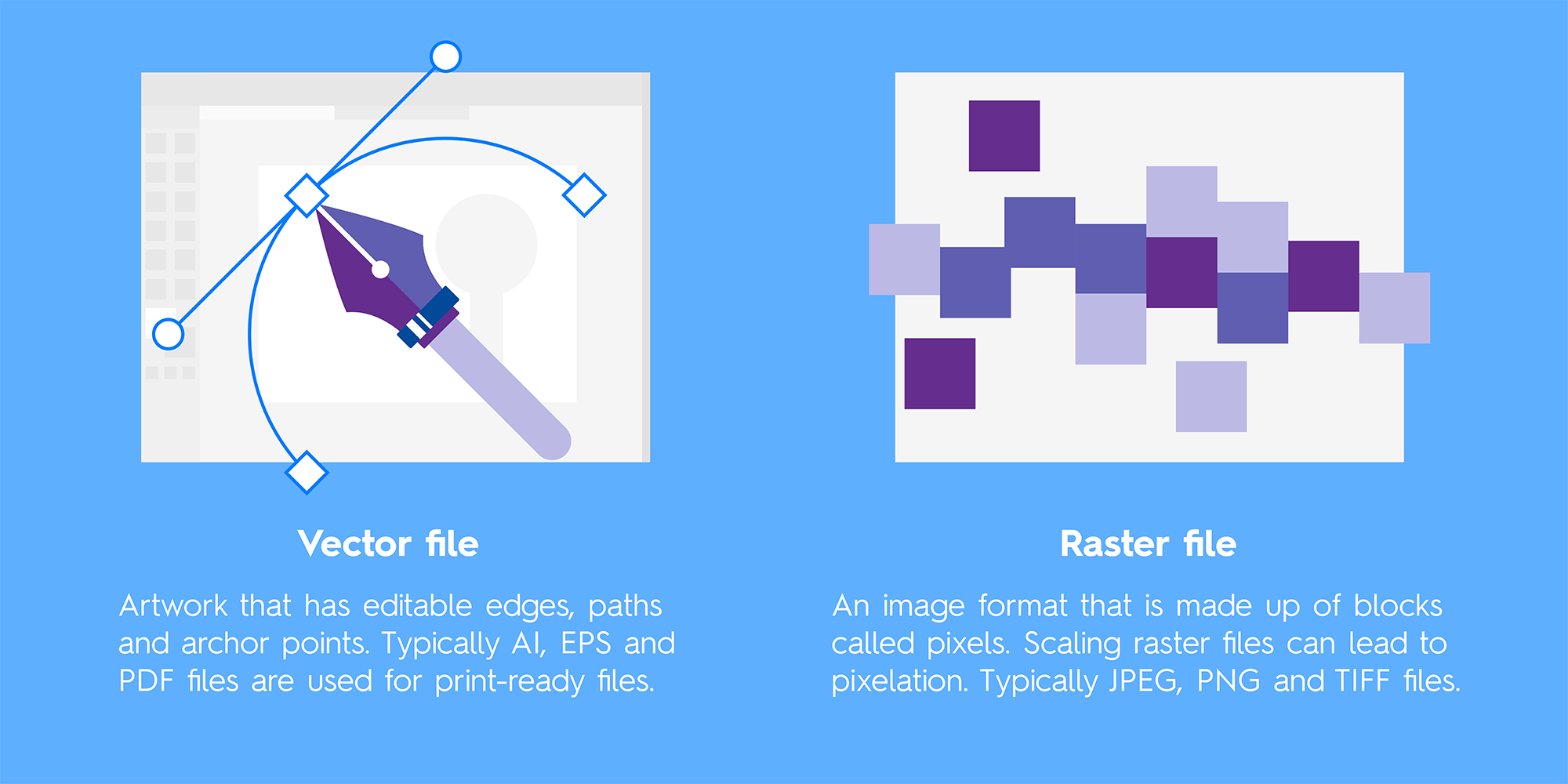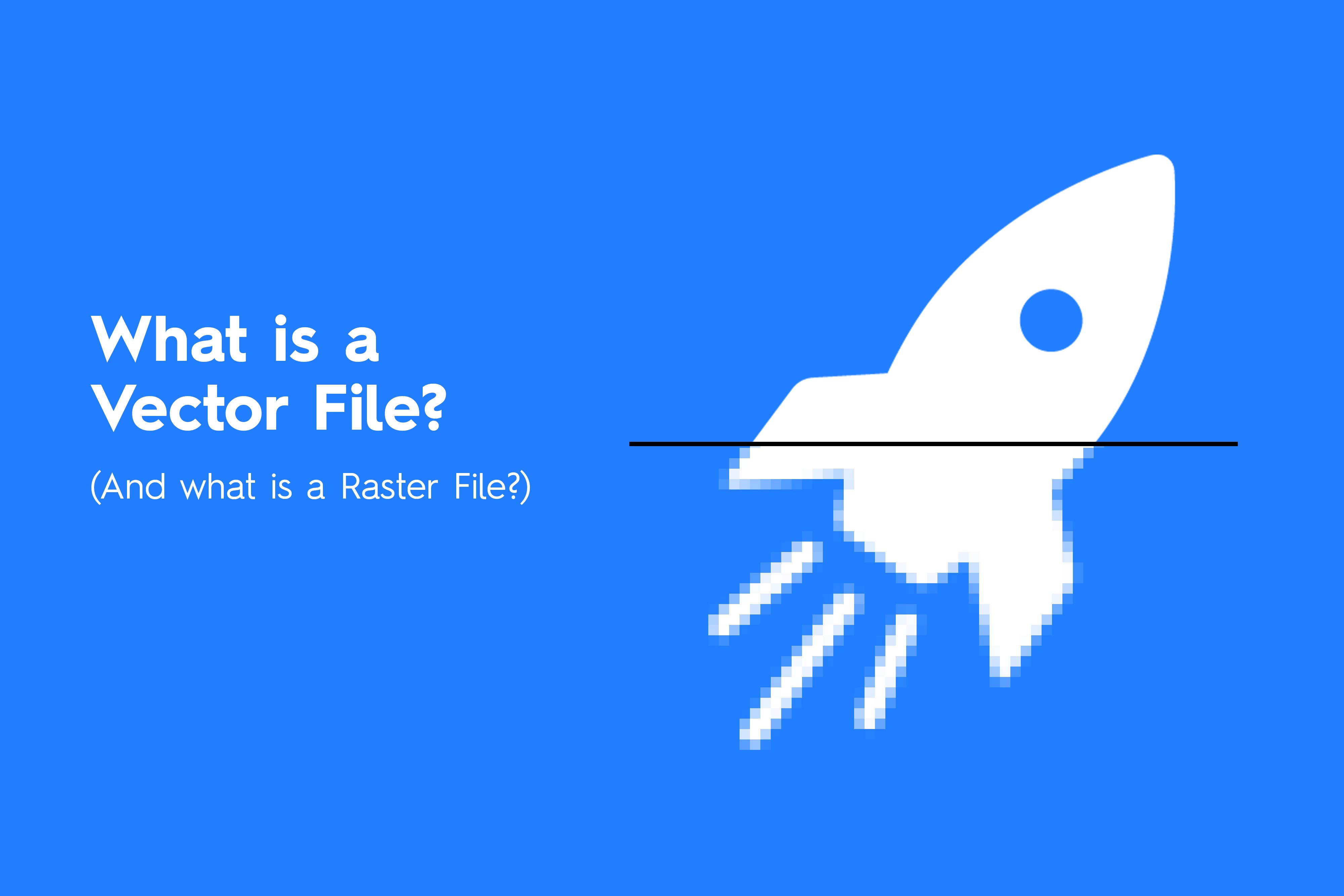If you’ve ever dabbled in the world of design or digital illustration, chances are you’ve heard the term “vector file” thrown around. But for those who are unfamiliar with this design terminology, you might be asking, what exactly is a vector file? And why is it so important? Today, we’re explaining what a vector file is, and exploring the differences between a vector and a raster file.
Vector Files: Digital (and Print) Design Hero
Think of a vector file as a superhero. It’s an artwork format that’s all about geometric shapes, lines, curves, and points, all neatly described by mathematical equations. Unlike pixel-based images (like JPEGs or PNGs), which rely on a grid of dots. Vector files are like elastic – you can stretch them as much as you want without losing quality or getting pixelation. Now, that’s exactly what you want when you want to print something with precision.
Adobe Illustrator: Where vectors come to life
Let’s chat about Adobe Illustrator. It’s the go-to software for creating and editing vector files. Whether you’re creating a logo or merch artwork, there are no design limitations in Adobe Illustrator.
Common Vector File Formats
Adobe Illustrator can save your creations in a variety of vector file formats, including:
- AI (Adobe Illustrator): This is Illustrator’s native format. Easy to manage layers and vectors for future tweaks.
- EPS (Encapsulated PostScript): A versatile format that can be opened in both vector and raster-based programs, like Adobe Illustrator and Adobe Photoshop. Layers are kept intact when you open the file in Illustrator.
- PDF (Portable Document Format): This can be opened in Adobe Illustrator with the layers still editable. This type of file can also be opened in Adobe Photoshop.
Why vector files are great to use
- Endless Scalability: As we mentioned earlier, vector files can be scaled up or down to any size without losing any detail. Perfect for anything — from small keyring designs to massive billboards!
- Crisp and Clean Lines: Vectors are all about crisp lines and sharp curves. Since they’re defined by mathematical equations, your artwork stays lookin’ sharp and professional.
- Edit, Edit, Edit: One of the best bits about vector files is how easily you can tweak your artwork without sacrificing quality. Change colours, tweak shapes, and get as creative as you want!

Raster Files: Pixels at Play
Think of raster images as finely crafted mosaics, made up of tiny blocks (also known as pixels). Each pixel has its own color value, and when you put them all together, you get those gorgeous images we see on our screens. Unlike vectors, which are all about math, raster files are like a grid with a fixed resolution.
Adobe Photoshop: Where rasters come from
For anyone ready to tackle digital image editing, Adobe Photoshop is your go-to superhero. It’s the gold standard for workin’ with raster files, chock-full of tools and features to transform your images into visual masterpieces. Because of this, Photoshop is our least recommended program to create Print-ready files.
Common Raster File Formats
Adobe Photoshop can save your creations in a variety of raster file formats, including:
- PSD (Adobe Photoshop Document): Photoshop’s native format, PSD files keep all your layers, masks, and editing features intact. Perfect for projects you’ll be tinkering with again and again.
- JPEG (Joint Photographic Experts Group): These are the go-to for photos and web images. But be mindful – too much compression can mean a dip in quality.
- PNG (Portable Network Graphics): PNGs are known for their love of transparent backgrounds and their lossless compression. They’re used primarily in digital design and web graphics.
- TIFF (Tagged Image File Format): TIFF files are the A-listers of professional printing and archiving. They keep high-quality image data without compressing it, so quality stays top-notch. Plus, you can open a TIFF file in Adobe Photoshop and still have access to the original editable layers.
Why raster files are useful
- Photorealistic: Rasters are perfect for photos, digital paintings, and anything where you want to capture real-world textures and details.
- Image-Editing: If you need to tweak photos, colour correct, or add filters, raster files are your trusty sidekick. Photoshop’s got a whole range of tools to make your images pop.
- Universal Compatibility: Raster file formats like JPEG are universally supported, so they’re great for sharing your work on all sorts of platforms.
To Wrap It Up…
When it comes to providing your artwork for your merchandise, vector files are the way to go. Our graphic design team can easily edit the vector files, changing your artwork colours, adding a pattern to your design, or whatever creative flare you want to add to your product. Vector files are the preferred file format for promotional product print set-up.
While raster files have there digital benefits, they’re not the preferred file formats for printing. Raster files like JPEG and PNGs are great to use for digital assets, especially on websites. But when it comes to scaling a design from different sized products vector files are the way to go.
If you want to know more about which type of file you should provide with your promotional product enquiry, then get in touch with our team — we’ll point you in the right direction and tell you which files to provide.
 Australian-Owned
Australian-Owned







